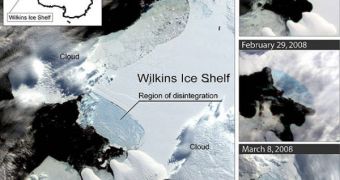Saturday saw the collapse of a tiny ice bridge, which kept the massive Wilkins Ice Shelf in place, in the northwestern part of Antarctica. Experts on-site said that the rupture was definitely caused by global warming, and that the ice gave way at its narrowest portion, which was less than 500 meters wide. The scientists also cautioned that the crack could be just the first in a series that could stretch throughout the region, threatening other ice shelves as well.
“It's amazing how the ice has ruptured. Two days ago it was intact. We've waited a long time to see this,” British Antarctic Survey Glaciologist David Vaughan told Reuters. He had access to a picture taken from a European Space Agency (ESA) satellite, which portrayed the Wilkins Shelf on the now-infamous Antarctic Peninsula, the place that is worst hit by rising temperatures. The image also revealed that the ice bridge, some 40 km (25 miles) long, ruptured in the place where most strain was applied to it, and that, at that point, there was little chance that it could repair itself.
The Wilkins Ice Shelf, while not as large and imposing as other blocks of ice, now reaches the size of Jamaica. It's the tenth shelf to have shrunken or disappeared completely on account of what looks like the influence of global warming on the Western part of Antarctica. Over the past decades, as interest in the region has grown, researchers have monitored the spread and the withdrawal of ice on several locations around the Southern Continent, and have found that not only is the western portion getting warmer, but that the eastern parts are beginning to show the same “symptoms” as well.
Experts say that some of the ice shelves that have collapsed over the last 50 years, including Larsen A (1995) and Larsen B (2002), are some 10,000 years old, and that the forming of new ones will take a few centuries. In addition, that may prove to be impossible now, seeing how the temperatures around the Arctic have grown by as much as three degrees Celsius over the past five decades. “We believe the warming on the Antarctic Peninsula is related to global climate change, though the links are not entirely clear,” Vaughan concluded.

 14 DAY TRIAL //
14 DAY TRIAL //